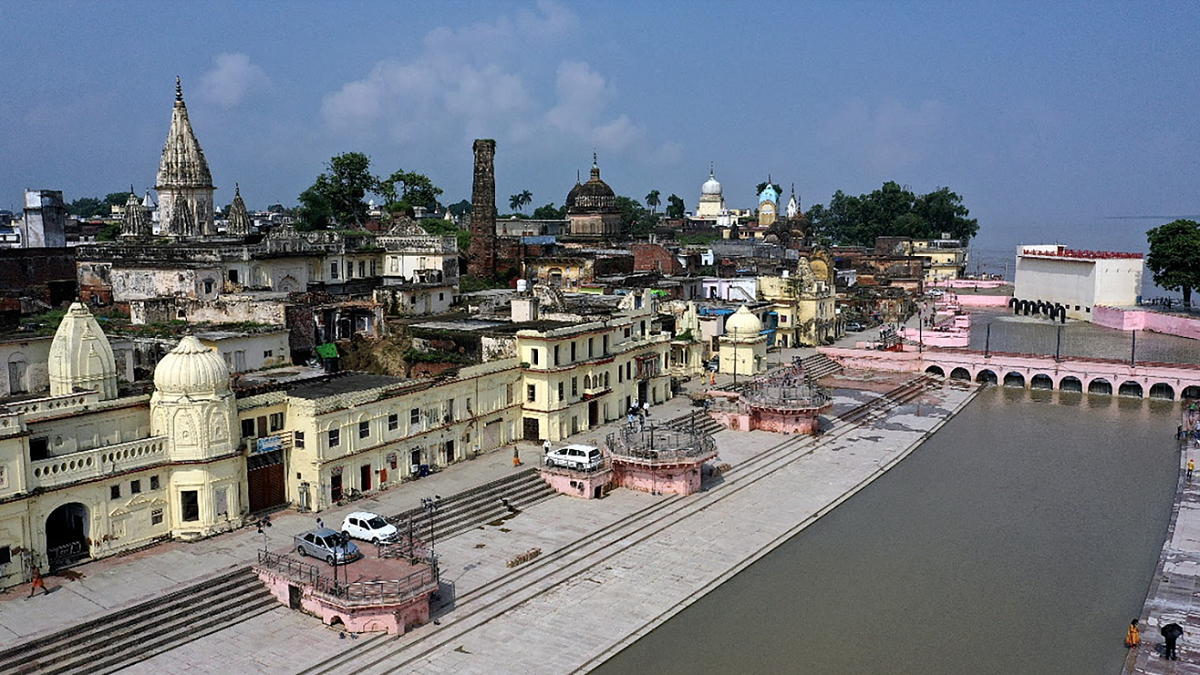Religion is the main source of income in Ayodhya. Until the 1960s, timber from the neighbouring Gonda district was sold from Ayodhya but even that trade was limited to adjacent districts. Today, timber merchants have long disappeared and the town relies solely on pilgrims for their income. Most of the residents describe their profession as “aakash vritti”, which literally means “what falls from the sky”. People depend on the gods for sustenance. Sufi, a businessman who sells cardboard boxes to sweet shops near Hanumangarhi, swears by the local harmony that exists between Hindus and Muslims. What he worries about is the lack of jobs and livelihoods in Ayodhya. Sufi says, “If the temples are shut for even one month for whatever reason, half of Ayodhya’s population will face starvation. It’s purely a pilgrim-based economy”.
The revenue model of Ayodhya’s temples is fairly simple — donations from devotees and rent from properties. Donations are made by the poor and the rich in cash and kind. For instance, a poor peasant family from Bahraich district comes to the seasonal melas every year and they stay in a designated temple. At the end of their stay they leave behind the rations they carried with them along with a small amount of money. It is understood by both pilgrims and pujaris that this is a donation. The pujari has given the family shelter and a place to set up their temporary brick stoves. Richer pilgrims also come laden with sweets and make offerings of money, mobile phones, air conditioners, bed linen, etc., and some take care of various repairs or construction work that might be required in their guru’s respective ashrams. This is in addition to the daily offerings of money that are made in the big, medium-sized and small donation boxes usually placed in front of the idols of deities. “Pray and pay” is an unwritten code followed by the devotees here. Ascetics, priests and mahants are seldom engaged in any kind of profession and the devout pilgrims are only too happy to make contributions towards the sustenance of the religious gurus.
Bigger temples run their own charities. Donations to religious trusts and charities are also a way of claiming tax deductions. By donating large amounts of money rich merchants are able to save income tax while earning ‘good karma’. The melas attract mainly peasants and other rural folks from near and far. Busloads of pilgrims, on package tours, descend on Ayodhya, from as far as Andhra Pradesh, Madhya Pradesh, Rajasthan and Gujarat and even as far as Nepal and Bengal during the mela months. The offerings of these pilgrims and the money they spend on food and buying sweets and other knickknacks are the real source of livelihood for thousands of people in Ayodhya. For richer temples like the Naka Hanumangarhi run by the Nirmohi Akhara in Faizabad, money is also earned by renting out their spacious buildings and grounds as venues for birthday parties, dinners and weddings.
The Ramayanic tradition of primogeniture had been broken in the Ayodhya royal family with Man Singh’s ascension in the late nineteenth century. The present heir to the throne of Ayodhya is a descendant from his grandmother’s side and therefore locals don’t consider him as the true heir. Prince Yatindra Mohan Mishra, an acclaimed poet and author, met me at Delhi’s Nehru Memorial Library & Museum where he was working on “some research on his next project”. Mishra, who runs the Maharaja Public School in Ayodhya, illustrated the importance of the melas to Ayodhya’s fragile, pilgrimdependent economy. “It is an ecosystem that really depends on the common farmer and farm labourer from neighbouring districts. When they have a good crop, they are able to spend more money in Ayodhya. If the harvest has been bad the income of Ayodhya’s shopkeepers and businessmen also go down. In the school that we run parents are usually able to admit their wards in August or later because that’s when they would have made some money during the Sawan Mela. I feel the economy of my town cannot be dependent only on the mela. We need industries and factories too,” he explained.
Notwithstanding the negative views of the locals, the Mishra family continues to represent Ayodhya in India and abroad, particularly in Oyoto, a sister-city of Ayodhya in South Korea. Mishra is a writer and poet who recently authored a book on India’s most celebrated singer, Lata Mangeshkar. Though the ‘days of royalty’ are long past, Mishra is aware of the weight and impact of his words and chose to refrain from commenting on the Ram Janmabhoomi-Babri Masjid dispute. But he didn’t hold back from saying, ‘I am a proud Hindu and a proud democrat who believes in progressive values.’ Like many locals who believe that writers and journalists highlight only the negative aspects of Ayodhya, Mishra too said, ‘So far whatever has been written about Ayodhya, it has been negative.’
Mishra seemed to hesitate while sharing his view about the VHP claims of Rama’s historicity or the development of Ayodhya as an organised centre of Ram worship. But he talked openly about himself, “I am a descendant of a royal family that patronised the legendary singer Begum Akhtar and artists like Pagal Dasji. More than anything else in my life, I want to preserve and enhance this intellectual, literary and artistic legacy of my family,” he said. Ayodhya’s royal family is one of the few Brahmin royal houses surviving in India. They have their own avenues of income including a large amount of real estate and educational institutions and are not directly affected by the ups and downs of the pilgrim bazaar of the town. Some of the biggest temples are also the biggest landlords and their landholdings are scattered in various states like Bihar, Uttar Pradesh, Chhattisgarh and Madhya Pradesh. Ramanujis once held control over the biggest land banks in Ayodhya. But with time the landholdings have shrunk as lands have been sold to sustain their temples and ashrams. ‘The offerings from pilgrims are not enough and the richer devotees are too few in number,’ said Acharya Dharmendra Upadhyaya, a third-generation owner of a Ramanuji temple in Ayodhya’s Vibhisha Kund locality.
Land may not be a source of income any more for Dharmendra Upadhyaya and Bhagvandas Acharyaji but there are other ways to generate money for wellestablished families like theirs. Bhagvandas rents a portion of his ashram to an astrology firm. He offers religious counselling by way of providing guidance for rituals and even sending digital versions of religious mantras and texts. “Just the other day, a lady devotee called me from Italy asking for a copy of the Hanuman Chalisa so I sent it to her on WhatsApp.” Did you charge her for that? I asked. “No, but it’s her wish if she wants to donate some money, she’s from Chandigarh, we have an ashram there also.”
The astrology firm in his building operates like any other business process outsourcing or customer care centre. Horoscopes are made and shared over email and WhatsApp in return for payments via e-banking. Besides, both Upadhyaya and Bhagvandas and other mahants travel across the country and stay at various temples and homes of devotees. At the end of each such stay, they are showered with gifts of money, food and other items. Most of the devotees they have today have been associated with their respective temples over generations. A devotee’s son becomes the disciple of the son of his father’s guru. In this sense, unless the guru or the devotee break ties, inherited discipleship remains fixed. It is up to the ingenuity of the guru to attract more disciples.
The big Ramanuji centres like Asharfi Bhavan attract devotees throughout the year but even the combined footfall in all the Ramanuji temples is a fraction of those who visit Ramanandi centres like Kanak Bhavan and Hanumangarhi.
Excerpts from the book, ‘Ayodhya: City of Faith, City of Discord’, published by Aleph.




















